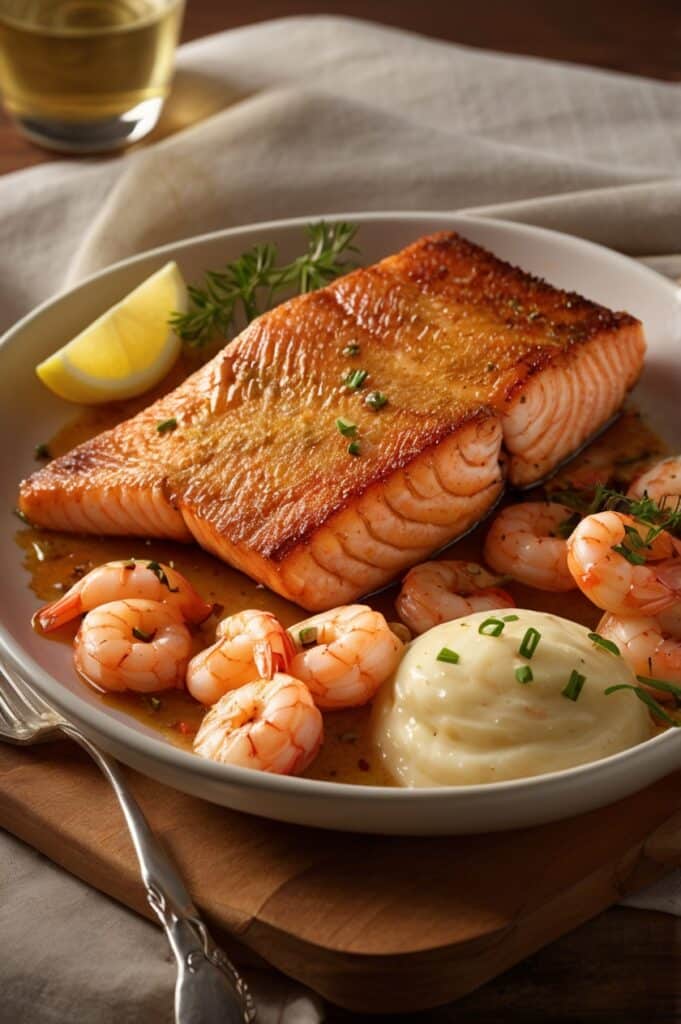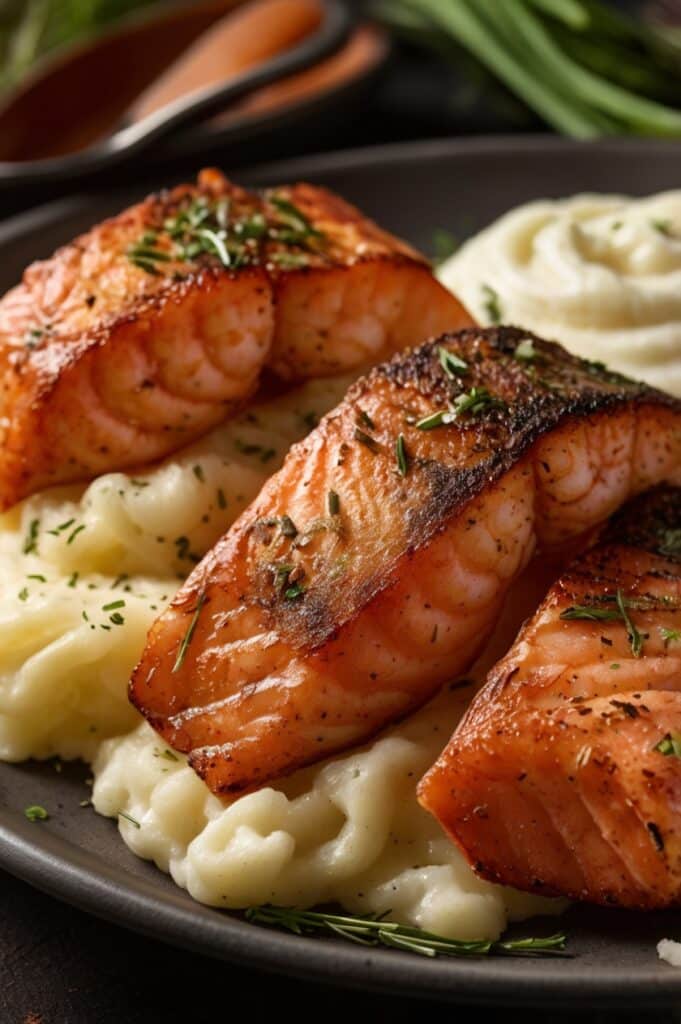Spicy Cajun Salmon & Shrimp Recipe—now there’s a mouthful that hits with heat, charm, and a buttery ocean whisper. I remember the first time I slapped a cast iron skillet on high, oil spitting like it was angry at the world, and dropped in salmon coated in Cajun fire. Smelled like Louisiana was calling me home. And shrimp? Shrimp came along for the ride, soaking up flavor like it owed the pan rent.
Spicy Cajun Salmon & Shrimp Recipe is a bold, soulful dish loaded with spice, smoke, and silky seafood texture. It’s Southern heat meets seared perfection, a main course that struts. What makes it special ain’t just the Cajun spices, though they’re a big part—it’s the way the fat from the salmon mingles with the creole butter shrimp in the same skillet. Rich. Tangy. Punchy. Fancy restaurant vibes but with that “your kitchen smells freakin’ incredible” kinda vibe.
Ingredients & Substitutions
Spicy Cajun Salmon & Shrimp Recipe starts with fresh, skin-on salmon fillets and large, peeled shrimp. You want about 4 salmon fillets (around 6 oz. each) and 1 lb of shrimp—tail-on for extra drama if you’re feelin’ photogenic.
- 4 salmon fillets, skin-on, fresh (or high-quality frozen, thawed)
- 1 lb large shrimp, peeled, deveined (tail on or off)
- 2 tbsp olive oil (avocado oil works too)
- 2 tbsp unsalted butter (or ghee for dairy-free)
- 1 tbsp Cajun seasoning (store-bought or homemade, more on that in a sec)
- 1 tsp smoked paprika (don’t skip—this is the soul)
- 1/2 tsp cayenne pepper (adjust to taste, or skip if a lil spice-shy)
- 3 garlic cloves, minced (fresh only, powder won’t do)
- Juice of 1 lemon (zest it first if you wanna get fancy)
- Salt & cracked black pepper, to taste
- Fresh parsley, chopped, for garnish
Substitutions:
Spicy Cajun Salmon & Shrimp Recipe is flexible. Use tilapia or cod if you can’t get good salmon. For shrimp, scallops are a luxe swap. Vegan? Swap seafood for tofu or jackfruit and use vegan butter. And if Cajun seasoning’s not on hand—quick blend: paprika, garlic powder, onion powder, thyme, oregano, cayenne, and a lil brown sugar.

Step-by-Step Instructions
Spicy Cajun Salmon & Shrimp Recipe kicks off with seasoning the protein like you mean it. Rub salmon generously with salt, pepper, Cajun seasoning, smoked paprika, and a little cayenne. Don’t skimp. This isn’t a time for shy spices.
Step 1:
Heat 1 tbsp oil in a cast iron or heavy skillet on medium-high. Place salmon skin-side down first—it crisps like a dream that way. Sear 3-4 minutes, then flip and cook 2 more minutes. Remove and rest. If it flakes under pressure of a fork, you’re golden.
Step 2:
In the same pan, melt butter with the rest of the oil. Toss in garlic, let it sizzle—but don’t burn it. Burnt garlic’s a crime in this dish. Add shrimp and cook 1-2 minutes per side until pink and curled tight like a smug comma.
Step 3:
Squeeze fresh lemon juice over the shrimp while they’re still in the pan. The acidity lifts everything. Return salmon to the pan, tuck it around the shrimp. Let ‘em mingle for a minute. Sprinkle chopped parsley. Take a breath—smells nuts, right?
Common Mistakes to Avoid:
Spicy Cajun Salmon & Shrimp Recipe can go south if you overcrowd the pan. Don’t. Sear in batches. Also, overcooked shrimp’s rubbery and tragic. Watch ’em like a hawk. And if your Cajun seasoning’s got salt already? Ease up on extra salt or you’ll end up in sodium jail.
Cooking Techniques & Science
Spicy Cajun Salmon & Shrimp Recipe uses searing to create contrast—crispy salmon skin, tender flesh, and juicy shrimp. The Maillard reaction (that golden-brown magic) kicks in when proteins hit hot oil. It’s flavor alchemy.
Cast iron makes a difference. It holds heat like a grudge and gives that signature crust. A non-stick pan just doesn’t bring the same heat drama. Also, finishing the shrimp in butter does more than add flavor—it emulsifies with lemon and spice, creating a natural pan sauce.
Science-y note:
Lemon juice helps balance the heat by cutting fat and enhancing umami. Shrimp’s high in glutamate, so when it meets acid and heat, it gives off that savory depth. Real layered flavor—not just spicy for the sake of fire.
Technique tip:
Let your proteins rest. Salmon keeps cooking off heat for a minute or two—this is carryover cooking. Resting = juicier bites.
Serving & Pairing Suggestions
Spicy Cajun Salmon & Shrimp Recipe deserves to be plated like it’s about to walk the red carpet. Use a wide white plate. Fan the salmon out, spoon shrimp around it, drizzle pan sauce over like it’s liquid gold.
Pair it with garlic mashed potatoes, creamy grits, or buttery rice pilaf. Want low-carb? Try roasted cauliflower rice or a crisp fennel slaw. Something crunchy cuts the richness.
Wine pairing? Sauvignon Blanc or off-dry Riesling cools the fire. Or go bold with a chilled rosé—not too sweet, not too dry. Beer? A hoppy IPA dances with the Cajun spice. And if you like mocktails, a citrusy spritzer with mint cools and refreshes.

Conclusion
Spicy Cajun Salmon & Shrimp Recipe is more than a meal—it’s a Southern symphony in a pan. It’s heat, depth, texture, and flavor colliding in glorious chaos. It’s the kinda dish you serve on a weeknight to feel like it’s Saturday night in New Orleans.
You’ve got crunch from seared salmon skin, juicy shrimp bathed in creole butter, and bright lemon notes cutting through. And the best part? It all cooks in one pan. Less mess. More magic.
If there’s one final chef-y tip? Don’t be shy with seasoning—but taste as you go. Cajun spice isn’t shy, and neither should you be. Let the flavors sing.
FAQs
How spicy is Cajun seasoning in this recipe?
Cajun spice can be bold, but it’s adjustable. This recipe leans medium-spicy. Want more fire? Add cayenne. Want less? Dial it back or use sweet paprika instead.
Can I make this recipe dairy-free?
Absolutely. Swap butter for vegan butter or olive oil. The richness will change slightly, but it’ll still taste bomb.
What’s the best shrimp to use?
Large, wild-caught shrimp hold their texture better. Fresh is ideal, but frozen and thawed works fine—just pat them dry to avoid steaming.
How do I know when salmon is cooked?
When it flakes easily with a fork and is opaque pink inside, it’s done. Aim for an internal temp around 125–130°F for medium. Overcooked salmon is dry and sad.
Can I prep anything ahead?
You bet. Season the seafood up to 12 hours in advance. Store it covered in the fridge. Bring it to room temp before cooking for even searing.

Olivia P. is a seasoned food blogger at Tastywink, sharing delicious, easy-to-follow recipes inspired by him passion for home cooking. With years of culinary blogging experience, he brings flavor, creativity, and a personal touch to every dish.
